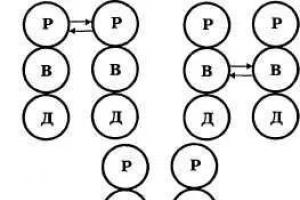Preparing wood antiseptic with your own hands: composition and properties of impregnation
The main destructive factors that reduce the strength and visual value of wood include rotting, damage by microorganisms (fungi) and insects. All negative impacts are interconnected and occur most intensely when high humidity. To increase the resistance of wood to destructive influences environment They use an integrated approach, which consists of reducing the moisture content of the wood and impregnating it with chemical reagents.
The use of antiseptic compounds prevents the appearance of flowering and wood-boring beetles, and also accelerates the process of restoring the structure of the product after complex cleaning or repair. The products used can be home-made or factory-made. Factory mixtures are considered the most effective and usually contain substances of organic origin. They are more toxic to the body and require strict adherence to recommendations for use.
Do-it-yourself formulations are often no less effective, but are significantly cheaper. The complexity of preparing antiseptics for treating wood is low. It is important to use hand and face protection (gloves and masks) as you are handling a lot of substances. The composition of the solution depends on the goals set for protecting the wood and how it is used.
Are bitumen and salt mixtures safe?
Some antiseptic impregnation compositions are used to deeply protect wood buried in the ground. Mixtures for treating the external surfaces of a house or gazebo have a more gentle effect, as well as interior decoration premises.

Antiseptics for the most effective protection are non-aqueous mixtures based on used motor oil or bitumen. Advantages of such compositions:
- a viscous coating made from heavy petroleum products effectively protects the product from the penetration of moisture and air oxygen;
- the anaerobic environment of a tree protected by bitumen stops the development of bacteria and fungi, destroying existing colonies of microorganisms;
- Wood-boring insects cannot appear in wood treated with bitumen or oil. For their existence, only weakened (rotten) wood and the absence of resins and hydrocarbons harmful to any organism are necessary.
Treated with heavy petroleum products (often with the addition of coke chemicals), wood does not deteriorate in the ground for years. Suffice it to recall the telegraph poles that have stood for decades without a hint of rotting.
Disadvantages of preparing and using resin (bitumen) and oil mixtures:
- toxicity of components;
- highly flammable if not prepared correctly;
- high soilability of the compositions, which are almost impossible to wash off if they get on clothes;
- unpleasant odor;
- impossibility of use due to unpleasant odor and indoor toxicity.
Traditional mixtures for treating wood are aqueous solutions of salts - sodium fluoride and copper or iron sulfate. Their low concentrations are used to coat external and internal parts wooden structures and finishing items. More saturated compounds help protect buried piles or boards.

Advantages of saline aqueous solutions:
- less toxic than non-aqueous impregnations. The greatest danger is posed only by copper sulfate ( copper sulfate), which can cause severe poisoning if swallowed;
- simplicity and safety of preparation. Heating the mixture over an open fire is no more dangerous than a regular fire;
- ease of transportation. Bitumen or oil are more difficult to transport to the place of application, but salts are easily transported over any distance.
The disadvantages of aqueous antiseptics include:
- lower degree of wood protection than non-aqueous viscous mixtures;
- ability to be washed off with water after use;
- the need to apply insulating coatings to consolidate the effect.
All protective drugs should be used on the territory of the household with caution, especially during the harvest period. Contact of substances with fruits can lead to poisoning, so preparation and application of an antiseptic should be carefully considered.
Impregnation for wood: main components and preparation process
Bitumen solution for wood processing
The preparation contains not only bitumen, but also a diluent - diesel fuel or gasoline. Bitumen containing diesel fuel will harden for a long time and will have time to saturate the treated surface more strongly. The use of gasoline speeds up the hardening time and is useful when there are time constraints on the work.

Bitumen thinners are sold at gas stations, and used oil can be purchased at service stations. Bitumen is purchased in construction stores or on construction sites. Officially sold bitumen is more viscous and well packaged, which improves its transportation.
Remember! When buying and using gasoline, use only metal containers. Static electricity from polymer containers can cause fire and burns .
In addition to the initial components, to work you must have:
- container for heating bitumen;
- device (stops) for fixing the container over a fire or burner;
- metal stirrer.
Cooking process bitumen composition is as follows:
- bitumen is poured into a metal container and placed above the intended source of open fire;
- turn on the burner or light a fire, gradually increasing the heat;
- heat the bitumen until completely liquefied, stirring occasionally to dissolve lumps;
- extinguish the fire after bringing the bitumen to a slightly viscous state and set the container with it aside;
- Solvent is added in small portions, controlling its splashing due to heating. Gasoline will actively evaporate, so you should wait until the mixture cools a little.
The proportions of bitumen and thinner depend on the initial state of the bitumen. The main criterion is that the final mixture is in a liquid state at room temperature. The content of diesel fuel or gasoline is usually about 20-30% of the total mass, but may vary depending on the nature of the viscous component.
If the heating of the bitumen is rapid, the mixture may foam and spill over the edge of the container directly onto the fire. This occurs due to the presence of water in the bitumen. Slow heating will stop this process and allow the water to boil away calmly.
The preparation time for the bitumen preparation takes several hours. Depending on the amount of work, you can complete it in two hours or spend the whole day. The resulting mixture is a viscous mass that has high adhesion to any wood surface. Leave on long-term storage bitumen does not cost, it is consumed immediately after cooling and diluting with a lighter petroleum product.
The mixture should be prepared exclusively outdoors to avoid inhaling harmful fumes and causing an accidental fire. Bitumen antiseptic should be applied using brushes with long handles. You can also immerse part of the tree in a container with a solution. After drying, the bitumen layer is very difficult to damage, so the products become suitable for burying in the ground.
Preparation of an aqueous mixture and the process of treating wood with copper sulfate

Salt-water solutions are prepared by dissolving a given amount of salt in heated water. Heating is necessary to increase the speed and completeness of dissolution. There are different proportions for treating wood with sodium fluoride and iron or copper sulfate:
- for impregnation wooden surfaces For domestic buildings, a weak solution of sodium fluoride is used. Its content ranges from 0.5 to 4% (from 50 to 400 g per 10 liters of water), depending on the purpose of the structure. Inside the house it is enough to use less concentrated mixtures, while outside (gazebos, benches) it is better to use saturated solutions. To visually control the completeness of application, add 10 g of potassium permanganate (potassium permanganate) to the resulting solution. Intense coloring will not be durable and will disappear soon after covering the surface. The solution should be applied with a spray bottle or a wide brush;
- To treat pillars and structures buried in the ground, sulfate mixtures containing the target component of 10-20% (1-2 kg per 10 liters of water) are used. Such compositions require particularly careful drying and long soaking times in order to improve the effect of application. The quality of application of the antiseptic is controlled by the degree of coloring of the product, which is facilitated by the rich color of the vitriol solution. The resulting preparation soaks parts of the wood that will subsequently be exposed to negative external influences.
To prepare the water mixture you will need a source hot water, cooking container and stirring spatula. Using the solution after settling makes it possible to load it into a sprayer, improving the uniformity of the coating and reducing the consumption of reagents. Impregnation can be applied immediately after cooling. Solutions can be stored for several days until suitable weather conditions are established.
The preparation of aqueous solutions can be carried out at home or outdoors. At home, you need to be especially careful not to spill excess solution on things or in hard-to-reach crevices. The total preparation time for antiseptic rarely takes more than an hour.
To avoid mistakes when dosing components, study the characteristics of the wood you are going to process. There are complex approaches to processing, including cutting off a layer of wood and varnishing the salt-impregnated surface.
Comparison of purchased and homemade antiseptics
Advantages of a DIY solution:
- lower cost;
- high efficiency in the case of bitumen or oil composition;
- less toxicity;
- minimal likelihood of purchasing counterfeit products.
Advantages of purchased factory-produced drugs:
- greatest efficiency;
- easy to prepare (ready after mixing with water or a non-aqueous solvent);
- selectivity of influence.

The choice of wood processing tool remains up to the user. The quality of the resulting wood protection when using self-made impregnation may be inferior to more expensive factory mixtures. For use inside the house, it is advisable to buy a complex product that will have not only an antiseptic, but also a fire-fighting effect.
Self-prepared antiseptics are several times cheaper than ready-made commercial formulations and are quite effective. The scope of application of such mixtures is not limited to exterior work and includes a number of compositions for use inside the home. The degree of protection can be adjusted by the thickness of the applied impregnation layer and the concentration of its aqueous solution, ensuring the suppression of any wood-destroying influences.
http://derevo-s.ru
Cooking recipes and methods of application.
If you have started building a house or decorating a room using wooden elements, You will definitely need special means for surface treatment. But, unfortunately, not everyone has the budget to purchase them. If you are forced to save money, we recommend creating a solution for processing the material yourself.
How to make wood impregnation You will find out for yourself in our article. Various recipes, proven over the years, can be found on the Internet. We will look at the most popular ones.
Recipe for preparing bitumen-based impregnation
To create such a product you will need bitumen, diesel fuel or gasoline.
Bitumen should be poured into a bucket, brought to a boil, and then diesel fuel should be poured in doses. Its volume should be such that after cooling the mixture remains liquid.
This antiseptic penetrates deeply into the structure of the wood, in no way inferior to expensive compounds. The absorption depth can be up to 6 mm. It is also easy to create a quick-drying impregnation; for this, diesel fuel is replaced with gasoline. Please note that in this case heating of the solution is excluded.
After use bitumen-based impregnations additional coating using special enamels is recommended for oil based. The use of nitro paints and nitro varnishes is prohibited.
The main advantages of such antiseptics are reliable protection against the penetration of moisture and oxygen; preventing the development of various microorganisms; eliminates damage by wood-boring insects; creates a durable coating without rotting. As for the disadvantages: toxicity, easy flammability, high soiling, strong unpleasant odor, not suitable for indoor work.
No less effective when processing wood is salt impregnation.
Recipe for salt-based impregnation


- The main substance used is sodium fluoride in the amount of 25 kg.
- The product is immersed in a container of 400 liters of water and diluted until smooth.
- Next, the log house is processed using a special apparatus for airless painting under a pressure of 200 bar.
- Simultaneously with processing it is removed upper layer wood Then the surface is ground using a 40 flap wheel and moved final processing oil, varnish or other means.
The advantages of salt-based impregnation include lower toxicity compared to aqueous solutions. The disadvantages are a lower degree of protection; ability to be washed off with water; the need to use additional coatings for fixation.
The use of synthetic impregnations is unsafe, especially for interior works. The substances included in the composition are toxic and flammable. To create an environmentally friendly wood treatment, it is recommended to use vegetable or natural beeswax. Wax impregnation is absolutely safe, gives the surface a pleasant aroma, makes it resistant to mechanical damage, gives water-repellent properties, emphasizes the beauty and texture of wood, creates a beautiful matte finish with shine.
The solution consists of turpentine and wax, taken in a ratio of 1:2. To process food-grade wood products, oil is mixed instead of turpentine in a 2:1 ratio.
Recipe for making wax impregnation

Ingredients: 25 g crushed rosin, 100 g wax, 50 g purified turpentine.
For cooking, it is better to use enamel dishes.
The wax must be melted in a water bath, then add rosin.
After that, turpentine is gradually poured in, which gives the wood a pleasant aroma and generally strengthens the surface.
One of the most effective antiseptics is copper sulfate. The saturated solution provides reliable protection boards buried in the ground. Its use in the area personal plot during the harvest period it is carried out with caution, because may cause severe poisoning upon contact with fruits.
Antiseptic recipe:

Ingredients: 100 g of iron sulfate, 10 g of potassium permanganate, 10 l of water.
To prepare the solution it is better to use plastic canister volume 25 l.
The ingredients are diluted in a canister, after which the solution is ready for use.

For interior work, it is possible to use less concentrated salt impregnations. It is recommended to apply the solution with a wide brush or using a spray bottle.
Impregnations based on copper sulfate require a long impregnation time and thorough drying.
Storage of solutions is possible for several days after preparation.
Before creating a mixture, it is recommended to familiarize yourself with the characteristics of the wood intended for processing in order to eliminate errors in the dosage of components. For self-cooking It requires a lot of time, as well as selecting the components in advance. In addition, almost all of the above impregnations are suitable only for external use, because... toxic. That is why, for safety reasons, it is better to use high-quality LuxDecor wood impregnation products.
– valuable, natural construction material. Buildings made from it have a good microclimate, an optimal level of humidity, they are warm and comfortable in winter, and quite cool in summer.
But the material is organic, and therefore various biological factors pose a danger to it: insect pests, bacteria, and much more. Therefore, the tree needs reliable protection.
Combined
Which antiseptic do you prefer? How to make a choice?
 In order to select the composition that is optimally suitable for quality, it is necessary to take into account several important factors. This is the density and porosity of the material, its ability to absorb, the type or type of wood.
In order to select the composition that is optimally suitable for quality, it is necessary to take into account several important factors. This is the density and porosity of the material, its ability to absorb, the type or type of wood.
By durability tree species usually divided into the following groups:
- Persistent. They are characterized by resistance to rotting processes, reliability, strength and durability. These include oak, pine, larch core and ash.
- Medium resistant. They have lower resistance to decay processes. These include sapwood, spruce, cedar and fir.
- Low resistance. They are not as durable and reliable as the two types already noted. These include the sapwood of oak, maple, beech, birch, and elm core.
- Unstable. These are the types of wood that are more susceptible to negative putrefactive changes than others. These include alder, birch kernel, linden sapwood, and aspen.
- Easy to impregnate - these types include birch sapwood, beech and pine.
- With moderate ability - these include aspen, pine heartwood, oak, maple and linden sapwood.
- Difficult to impregnate - spruce, ash, oak and birch cores.
Use of antiseptics: classification by purpose
 Banding and antiseptic treatment
Banding and antiseptic treatment All drugs can be divided into two conditional type, depending on their main purpose:
- Preventive. They are used at the very beginning of construction or even before the start of the process. It is quite acceptable to begin processing with such material immediately after the necessary lumber has been purchased. It will be possible to begin priming and painting only when one or two layers of the preparation are completely absorbed into the surface of the wood.
- Medicinal. They are resorted to in cases where problems with the material have already appeared and need to be eliminated. For example, wood has undergone putrefactive processes, or has been damaged by microorganisms and insects - these are the types of products that can help it. Therapeutic antiseptics can also be used as prophylactics, in cases where it is known in advance that the operating conditions of the potential structure will be unfavorable. For example, this will be high humidity.
Antiseptic solutions: classification by use
Most suitable composition antiseptics are selected depending on the type of wood, and based on the purpose of the material. The features of processing wooden products also depend on this. According to the method and area of application, all antiseptics can be divided into two types.
 For outdoor use
For outdoor use
External preparations are substances that are used to protect wooden parts exposed to harsh outdoor conditions.
Since these objects are actually in the open air, they quite often experience the influence of the environment: ultraviolet radiation, precipitation, sudden changes in temperature, etc.
Therefore, the external antiseptics used in this case must be durable and of high quality, providing reliable protection.
They often have a sharp, specific odor, which can only be gotten rid of after the treated material has completely dried. This may take from one month to two.
These substances tolerate solar radiation and the negative effects of high humidity well, but they are not intended for interior use.
They, in turn, are divided into two groups:
- impregnations - these compositions are intended for deep penetration into tissues to destroy insects and fungi in them;
- finishing coatings – designed to protect the impregnating layer from weathering. They do not penetrate deep into the fibers, but they form a special protective film on the surface of the processed material.
Both finishing preparations and impregnation antiseptics can be used separately, but often owners choose combined products that have different functions.
For interior work
 These compositions are characterized by one feature: after processing, a microfilm is formed on the surface of the material. It seems to clog toxic substances, not allowing them to erode. This is very important for substances used for, since it ensures not only the safety of the wood, but also safety for the health of people in the room. These products are quite stable and do not require regular subsequent application.
These compositions are characterized by one feature: after processing, a microfilm is formed on the surface of the material. It seems to clog toxic substances, not allowing them to erode. This is very important for substances used for, since it ensures not only the safety of the wood, but also safety for the health of people in the room. These products are quite stable and do not require regular subsequent application.
The specific type of drug is selected depending on the purpose of the room being treated. If an antiseptic is selected for treating surfaces in a room where the presence of high temperature and extremely high humidity, products for saunas and baths are suitable. It is necessary to study the performance characteristics of the drug indicated in its passport. It is better to buy drugs from reputable companies to avoid unpleasant surprises.
Wood is in great demand in construction, and its scope of application is limitless, since this material has many advantages and is aesthetically pleasing. But it is not without its shortcomings. Wooden products are easily flammable, are afraid of moisture, and also various insects infest them, which leads to the unsuitability of the products.
Wood is one of the most popular materials for construction. However, without proper treatment, it is susceptible to fungus.
These problems have always worried builders, but there are many protective measures that can protect the material from the effects of mold and fungal infections. Do-it-yourself wood impregnation will better protect the material from the destructive effects of the environment and fire.
As a rule, those who impregnate the wood with a special solution have an advantage, which helps to increase its service life.
Applications of impregnation: features

To prevent the wood from cracking, it must be treated with a moisture-repellent agent.
To save wooden crafts from sudden exposure to a humid environment and to protect it from cracking, it must be impregnated with waterproof and water-repellent compounds. In practice, this type of treatment is necessary to protect any wooden products, be it doors, windows or other possible interior items that may harbor biological lesions. Antiseptic impregnations not only protect the material, but also prevent their further development and appearance.
Impregnation of wood with fire retardants, which prevent combustion, provides the material with fire-resistant qualities. Impregnations play a protective role and are divided into the following types:
- antiseptic;
- fire retardant;
- combined composition;
- a solution that provides protection from the effects of the atmospheric environment.
Special moisture impregnation is used to protect wood from possible deformation and cracks.
These types of damage spoil the exterior interior and reduce quality wooden material. The highest possible quality can be achieved by impregnation with specially manufactured compounds using autoclaves.

The Senezh water-repellent solution penetrates deeply into the wood and thereby increases its strength.
Together with other coatings against the influence of the external environment, the water-repellent solution “Senezh” is also used, which is used to impregnate wood as a primer. It penetrates deeply into the pores of the wood, which affects its strength. Such compositions have excellent absorbency without forming a film, allowing the wood to pass air, which increases its service life. The composition is unique in that it is able to stop the process of decay that has begun and is an antiseptic for wood, which is in constant contact with moisture. Due to this wood impregnation, many products, such as rafters and joists, are fire-resistant and difficult to ignite.
Fire retardants play a protective role in wood against fire, since wood is easily susceptible to combustion processes. After impregnation with fire retardants, wood products become difficult to burn and non-flammable. For example, this prevents fire from a cigarette or an accidental spark. Fire retardant impregnations include the composition "Tikkuril". In addition to this impregnation, the company’s product range includes oils that give the material a water-repellent effect, and antiseptic solutions that protect the material from biological influences.
Return to contents
What are these compounds capable of?

Fire retardants form a protective film that protects wood from fire.
- Fire prevention.
- Suppressing the growth of fire at the initial stage.
- Passive localization of fire areas.
This composition has its unique qualities due to special additives, which form a thin film when the temperature rises. Because of this, fire-resistant impregnation for wood prevents oxygen from reaching the source of ignition and suppresses the combustion process.
By using antiseptics for wood products, they ensure increased vital activity and safe use. Almost all wooden products used in the construction and decoration of buildings can be treated with this composition.
Antiseptic solutions are used to protect wood from biological influences - various types fungi, mold spores, from all kinds of bugs and larvae. Before applying the solution, it is recommended to degrease and clean the surface of the wood, and only then treat the surface using a roller or brush.
Antiseptic impregnations consist of chemical substances- biocides that suppress the vital ability of biological organisms.

If the area to be treated is small, then use a paint brush.
You can apply antiseptic agents to a wooden surface with your own hands in three ways:
- Apply the product with a paint brush.
- Treat wood using a sprayer.
- Completely immerse the product in the biocide-containing preparation. The solution must be heated. This impregnation method is considered more effective; it is carried out only in specialized conditions, mainly industrially in autoclaves.
Antiseptic agents include many different compositions: copper and inkstone, sodium fluoride, substances with an oily structure, clay, bitumen and extract pastes. These products are good as protective products, but they are not aesthetically pleasing.
The selection of antiseptic impregnations for wood should be approached with special attention and get advice from the seller about the specifics of the product. Sometimes drugs, acting as protection against fungal infections, can change the color of a wooden product.
The main destructive factors that reduce the strength and visual value of wood include rotting, damage by microorganisms (fungi) and insects. All negative impacts are interconnected and occur most intensely at high humidity. To increase the resistance of wood to the destructive influence of the environment, an integrated approach is used, which consists of reducing the moisture content of the wood and impregnating it with chemical reagents.
The use of antiseptic compounds prevents the appearance of flowering and wood-boring beetles, and also accelerates the process of restoring the structure of the product after complex cleaning or repair. The products used can be home-made or factory-made. Factory mixtures are considered the most effective and usually contain substances of organic origin. They are more toxic to the body and require strict adherence to recommendations for use.
Do-it-yourself formulations are often no less effective, but are significantly cheaper. The complexity of preparing antiseptics for treating wood is low. It is important to use hand and face protection (gloves and masks) as you are handling a lot of substances. The composition of the solution depends on the goals set for protecting the wood and how it is used.
Are bitumen and salt mixtures safe?
Some antiseptic impregnation compositions are used to deeply protect wood buried in the ground. Mixtures for treating the external surfaces of a house or gazebo, as well as interior decoration, have a more gentle effect.
Antiseptics for the most effective protection are non-aqueous mixtures based on used motor oil or bitumen. Advantages of such compositions:
- a viscous coating made from heavy petroleum products effectively protects the product from the penetration of moisture and air oxygen;
- the anaerobic environment of a tree protected by bitumen stops the development of bacteria and fungi, destroying existing colonies of microorganisms;
- Wood-boring insects cannot appear in wood treated with bitumen or oil. For their existence, only weakened (rotten) wood and the absence of resins and hydrocarbons harmful to any organism are necessary.
Treated with heavy petroleum products (often with the addition of coke chemicals), wood does not deteriorate in the ground for years. Suffice it to recall the telegraph poles that have stood for decades without a hint of rotting.
Disadvantages of preparing and using resin (bitumen) and oil mixtures:
- toxicity of components;
- highly flammable if not prepared correctly;
- high soilability of the compositions, which are almost impossible to wash off if they get on clothes;
- unpleasant odor;
- impossibility of use due to unpleasant odor and toxicity indoors.
Traditional mixtures for treating wood are aqueous solutions of salts - sodium fluoride and copper or iron sulfate. Their small concentrations are used to coat the external and internal parts of wooden structures and decoration items. More saturated compounds help protect buried piles or boards.

Advantages of saline aqueous solutions:
- less toxic than non-aqueous impregnations. The greatest danger is only copper sulfate (copper sulfate), which can cause severe poisoning if swallowed;
- simplicity and safety of preparation. Heating the mixture over an open fire is no more dangerous than a regular fire;
- ease of transportation. Bitumen or oil are more difficult to transport to the place of application, but salts are easily transported over any distance.
The disadvantages of aqueous antiseptics include:
- lower degree of wood protection than non-aqueous viscous mixtures;
- ability to be washed off with water after use;
- the need to apply insulating coatings to consolidate the effect.
All protective drugs should be used on the territory of the household with caution, especially during the harvest period. Contact of substances with fruits can lead to poisoning, so preparation and application of an antiseptic should be carefully considered.
Impregnation for wood: main components and preparation process
Bitumen solution for wood processing
The preparation contains not only bitumen, but also a diluent - diesel fuel or gasoline. Bitumen containing diesel fuel will harden for a long time and will have time to saturate the treated surface more strongly. The use of gasoline speeds up the hardening time and is useful when there are time constraints on the work.

Bitumen thinners are sold at gas stations, and used oil can be purchased at service stations. Bitumen is purchased from hardware stores or construction sites. Officially sold bitumen is more viscous and well packaged, which improves its transportation.
When buying and using gasoline, use only metal containers. Static electricity from polymer containers can cause fire and burns .
In addition to the initial components, to work you must have:
- container for heating bitumen;
- device (stops) for fixing the container over a fire or burner;
- metal stirrer.
The process of preparing the bitumen composition is as follows:
- bitumen is poured into a metal container and placed above the intended source of open fire;
- turn on the burner or light a fire, gradually increasing the heat;
- heat the bitumen until completely liquefied, stirring occasionally to dissolve lumps;
- extinguish the fire after bringing the bitumen to a slightly viscous state and set the container with it aside;
- Solvent is added in small portions, controlling its splashing due to heating. Gasoline will actively evaporate, so you should wait until the mixture cools a little.
The proportions of bitumen and thinner depend on the initial state of the bitumen. The main criterion is that the final mixture is liquid at room temperature. The content of diesel fuel or gasoline is usually about 20-30% of the total mass, but may vary depending on the nature of the viscous component.
If the heating of the bitumen is rapid, the mixture may foam and spill over the edge of the container directly onto the fire. This occurs due to the presence of water in the bitumen. Slow heating will stop this process and allow the water to boil away calmly.
The preparation time for the bitumen preparation takes several hours. Depending on the amount of work, you can complete it in two hours or spend the whole day. The resulting mixture is a viscous mass that has high adhesion to any wood surface. It is not worth leaving bitumen for long-term storage; it should be consumed immediately after cooling and diluting with a lighter petroleum product.
The mixture should be prepared exclusively outdoors to avoid inhaling harmful fumes and causing an accidental fire. Bitumen antiseptic should be applied using brushes with long handles. You can also immerse part of the tree in a container with a solution. After drying, the bitumen layer is very difficult to damage, so the products become suitable for burying in the ground.
Preparation of an aqueous mixture and the process of treating wood with copper sulfate

Salt-water solutions are prepared by dissolving a given amount of salt in heated water. Heating is necessary to increase the speed and completeness of dissolution. There are different proportions for treating wood with sodium fluoride and iron or copper sulfate:
- A weak solution of sodium fluoride is used to impregnate wooden surfaces of domestic structures. Its content ranges from 0.5 to 4% (from 50 to 400 g per 10 liters of water), depending on the purpose of the structure. Inside the house it is enough to use less concentrated mixtures, while outside (gazebos, benches) it is better to use saturated solutions. To visually control the completeness of application, add 10 g of potassium permanganate (potassium permanganate) to the resulting solution. Intense coloring will not be durable and will disappear soon after covering the surface. The solution should be applied with a spray bottle or a wide brush;
- To treat pillars and structures buried in the ground, sulfate mixtures containing the target component of 10-20% (1-2 kg per 10 liters of water) are used. Such compositions require particularly careful drying and long soaking times in order to improve the effect of application. The quality of application of the antiseptic is controlled by the degree of coloring of the product, which is facilitated by the rich color of the vitriol solution. The resulting preparation soaks parts of the wood that will subsequently be exposed to negative external influences.
To prepare the water mixture, you will need a source of hot water, a container for cooking and a paddle for stirring. Using the solution after settling makes it possible to load it into a sprayer, improving the uniformity of the coating and reducing the consumption of reagents. Impregnation can be applied immediately after cooling. Solutions can be stored for several days until suitable weather conditions are established.
The preparation of aqueous solutions can be carried out at home or outdoors. At home, you need to be especially careful not to spill excess solution on things or in hard-to-reach crevices. The total preparation time for antiseptic rarely takes more than an hour.
To avoid mistakes when dosing components, study the characteristics of the wood you are going to process. There are complex approaches to processing, including cutting off a layer of wood and varnishing the salt-impregnated surface.
Comparison of purchased and homemade antiseptics
Advantages of a DIY solution:
- lower cost;
- high efficiency in the case of bitumen or oil composition;
- less toxicity;
- minimal likelihood of purchasing counterfeit products.
Advantages of purchased factory-produced drugs:
- greatest efficiency;
- easy to prepare (ready after mixing with water or a non-aqueous solvent);
- selectivity of influence.

The choice of wood processing tool remains up to the user. The quality of the resulting wood protection when using self-made impregnation may be inferior to more expensive factory mixtures. For use inside the house, it is advisable to buy a complex product that will have not only an antiseptic, but also a fire-fighting effect.
Self-prepared antiseptics are several times cheaper than ready-made commercial formulations and are quite effective. The scope of application of such mixtures is not limited to exterior work and includes a number of compositions for use inside the home. The degree of protection can be adjusted by the thickness of the applied impregnation layer and the concentration of its aqueous solution, ensuring the suppression of any wood-destroying influences.








